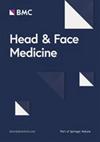正畸治疗前唇腭裂患者腭部形态和 PAS 的三维分析
IF 2.4
2区 医学
Q2 DENTISTRY, ORAL SURGERY & MEDICINE
引用次数: 0
摘要
由于颅面畸形及其与后气道间隙的关系存在多种不同的结论,这项临床对比研究调查了腭裂患者和非腭裂患者在正畸治疗前的腭部形态,包括体积大小、后气道间隙尺寸和腺样体。研究采用了 n = 38 名患者的口内三维扫描和头颅X光片来获取数据。患者分为三组:单侧唇腭裂(n = 15,4 女,11 男;平均年龄为 8.57 ± 1.79 岁)、双侧唇腭裂(n = 8,0 女,8 男;平均年龄为 8.46 ± 1.37 岁)和非唇腭裂对照组(n = 15,7 女,8 男;平均年龄为 9.03 ± 1.02 岁)。评估包括测量腭部形态和后气道空间的既定程序。统计数据包括口内三维扫描和头颅X光片的 Shapiro-Wilk 检验和简单方差分析(Bonferroni)。显著性水平设定为 p < 0.05。腭容积和头影分析表明三组之间存在差异。唇腭裂患者的腭容积、面后上方高度和鼻咽骨性深度明显小于非唇腭裂对照组患者。双侧唇腭裂患者的面后上方高度明显小于单侧唇腭裂患者(BCLP:35.50 ± 2.08 mm;UCLP:36.04 ± 2.95 mm;P < 0.001)。唇腭裂患者的腺样体占整个鼻咽部的百分比和 NL/SN 角明显大于非唇腭裂对照组。特别是,与非唇腭裂对照组相比,单侧唇腭裂患者的腭部体积小 32.43%,双侧唇腭裂患者的腭部体积小 48.69%。骨骼异常与后气道空间的尺寸有关。唇腭裂患者与非唇腭裂患者之间存在差异。这项研究表明,腭部的形态,尤其是上颌骨的横向缺损导致腭部体积较小,与后气道空间有关。甚至腺样体似乎也受到影响,尤其是唇腭裂患者。本文章由计算机程序翻译,如有差异,请以英文原文为准。
Three-dimensional analysis of palatal morphology and PAS in patients with cleft lip and palate prior to orthodontic treatment
Since many different conclusions of craniofacial anomalies and their relation to the posterior airway space coexist, this comparative clinical study investigated the palatal morphology concerning volumetric size, posterior airway space dimension and the adenoids of patients with and without a cleft before orthodontic treatment. Three-dimensional intraoral scans and cephalometric radiographs of n = 38 patients were used for data acquisition. The patients were divided into three groups: unilateral cleft lip and palate (n = 15, 4 female, 11 male; mean age 8.57 ± 1.79 years), bilateral cleft lip and palate (n = 8, 0 female, 8 male; mean age 8.46 ± 1.37 years) and non-cleft control (n = 15, 7 female, 8 male; mean age 9.03 ± 1.02 years). The evaluation included established procedures for measurements of the palatal morphology and posterior airway space. Statistics included Shapiro-Wilk-Test and simple ANOVA (Bonferroni) for the three-dimensional intraoral scans and cephalometric radiographs. The level of significance was set at p < 0.05. The palatal volume and cephalometric analysis showed differences between the three groups. The palatal volume, the superior posterior face height and the depth of the bony nasopharynx of patients with cleft lip and palate were significantly smaller than for non-cleft control patients. The superior posterior face height of bilateral cleft lip and palate patients was significantly smaller than in unilateral cleft lip and palate patients (BCLP: 35.50 ± 2.08 mm; UCLP: 36.04 ± 2.95 mm; p < 0.001). The percentage of the adenoids in relation to the entire nasopharynx and the angle NL/SN were significantly bigger in patients with cleft lip and palate than in the non-cleft control. In particular, the palatal volume was 32.43% smaller in patients with unilateral cleft lip and palate and 48.69% smaller in patients with bilateral cleft lip and palate compared to the non-cleft control. Skeletal anomalies relate to the dimension of the posterior airway space. There were differences among the subjects with cleft lip and palate and these without a cleft. This study showed that the morphology of the palate and especially transverse deficiency of the maxilla resulting in smaller palatal volume relates to the posterior airway space. Even the adenoids seem to be affected, especially for cleft lip and palate patients.
求助全文
通过发布文献求助,成功后即可免费获取论文全文。
去求助
来源期刊

Head & Face Medicine
DENTISTRY, ORAL SURGERY & MEDICINE-
CiteScore
4.70
自引率
3.30%
发文量
32
审稿时长
>12 weeks
期刊介绍:
Head & Face Medicine is a multidisciplinary open access journal that publishes basic and clinical research concerning all aspects of cranial, facial and oral conditions.
The journal covers all aspects of cranial, facial and oral diseases and their management. It has been designed as a multidisciplinary journal for clinicians and researchers involved in the diagnostic and therapeutic aspects of diseases which affect the human head and face. The journal is wide-ranging, covering the development, aetiology, epidemiology and therapy of head and face diseases to the basic science that underlies these diseases. Management of head and face diseases includes all aspects of surgical and non-surgical treatments including psychopharmacological therapies.
 求助内容:
求助内容: 应助结果提醒方式:
应助结果提醒方式:


